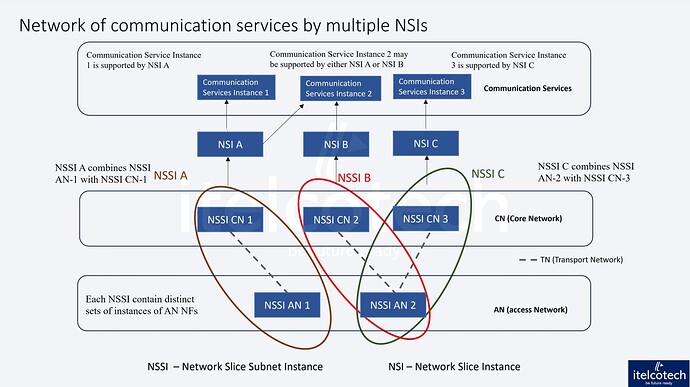Slicing is the technique to deliver various type of communication services (such as eMBB, URLLC, MMTC etc.) depending upon the requirement and needs of the different customers. Each communication service (Service Instance) here is provided using Network Slicing Instance (NSI).
Each Network Slicing Instance (NSI) is instantiated through multiple Network Slice Subnet Instance (NSSI), which consists of different network functions (access network: AN /core network: CN) and associated resources (storage, processing, compute etc.), example as follows -
Access NW : NSSI AN-1 and NSSI AN-2 each contain distinct sets of instances of AN NFs.
Core NW : NSSI CN-1, NSSI CN-2 and NSSI CN-3 each contain distinct sets of instances of CN NFs.
Transport network (TN) supporting connectivity facilitates the communication between CN and AN NFs.
NSSI A combines NSSI AN-1 with NSSI CN-1 and corresponding TN connectivity
NSSI B combines NSSI AN-2 and NSSI CN-2 and corresponding TN connectivity
NSSI C combines NSSI AN-2 with NSSI CN-3 and corresponding TN connectivity. The NSSI AN-2 is shared between NSSI B and NSSI C, while NSSI AN-1 is dedicated to NSSI A.
CSP offers NSSI A as a Network Slice instance NSI A, in this relationship NSI A represents NSSI A with associated Service Level Specification (SLS). It also offers NSSI B as NSI B and NSSI C as NSI C. The SLS of NSI A satisfies the service requirements of Communication Service Instance 1 and Communication Service Instance 2. The SLS of NSI B satisfies the service requirements of Communication Service Instance 2. The SLS of NSI C satisfies the service requirements of Communication Service Instance 3.
The Communication Service Instance 1 is supported by NSI A. The Communication Service Instance 2 may be supported by either NSI A or NSI B. The Communication Service Instance 3 is supported by NSI C.
Ref:3GPP
LinkedIn: ![]()
